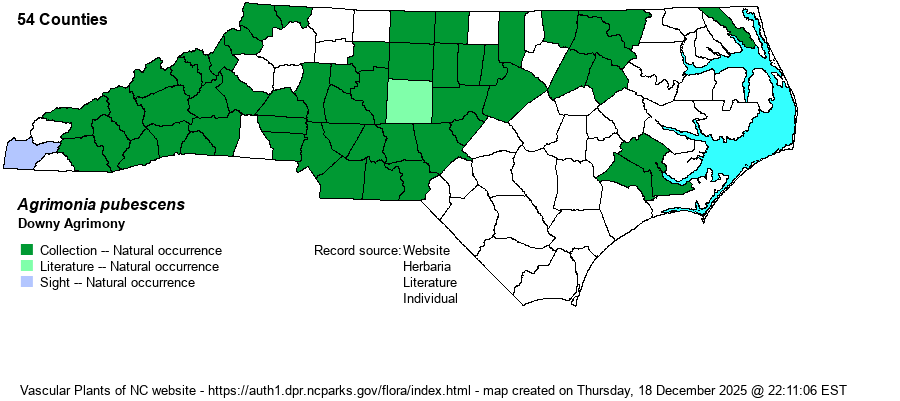| Author | Wallroth | |
| Distribution | Throughout the Mountains and Piedmont, and also ranges sparingly into the northern (and rarely eastern) Coastal Plain. The scarcity of records for the northwestern Piedmont is an artifact of collecting.
This is a widespread species, found in most counties in its range, from NY and MN on the north to GA and LA on the south.
| |
| Abundance | Frequent in the Mountains, and fairly common in the Piedmont. Scarce in the far northwestern Coastal Plain, and very rare south to Craven and Jones counties. As there are records for slightly over half of the state's counties, the website editors recommend a State Rank of S5. | |
| Habitat | This is a species of mostly dry to mesic forests, preferring somewhat high pH soil, but not a requisite. It often grows in openings and edges more than in deep shade, but nonetheless, this is a forest-based species of uplands. | |
| Phenology | Blooms from July to early September, and fruits from August to October. | |
| Identification | The genus Agrimonia has numerous species with distinctive leaves and flowering stalk, but the characters to separate many are quite technical, and biologists may have trouble keying them out. All have erect stems ranging in the vicinity of 3 feet tall, with alternate leaves that are distinctly pinnately compound, with small leaflets intermixed with much larger ones. Also, the inflorescence is a very long and slender spike-like raceme of tiny yellow flowers; these plants should be easily identified to genus level. In this species, the stem is fairly robust and reaches about 3 feet tall. It is quite hairy on the stem, without glandular hairs as in many others in the genus. The leaves have mostly 5-11 large leaflets (terminal and two to five sets of large leaflets on the side), along with small leaflets along the rachis. The large leaflets tend to be elliptic and acute, and they are quite velvety-pubescent below. This species is quite similar to A. microcarpa, as neither have glandular stems and racemes, but that species has the stipules at the bases of the leaves deeply cut into sharp teeth, as opposed to less incised stipules in this species. Also, A. pubescens tends to have at least 5 large leaflets, as opposed to mainly just 3 in A. microcarpa, which also has its leaflets quite obtuse or rounded toward the apex.
| |
| Taxonomic Comments | None, though RAB (1968) had A. microcarpa included with it as a variety, and thus this taxon was named as A. pubescens var. pubescens. Nearly all references have always had these two as separate species.
| |
| Other Common Name(s) | Soft Agrimony | |
| State Rank | S4 [S5] | |
| Global Rank | G5 | |
| State Status | | |
| US Status | | |
| USACE-agcp | | |
| USACE-emp | | |

